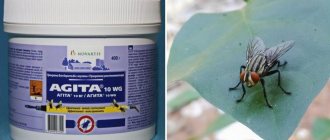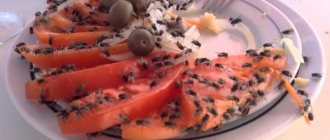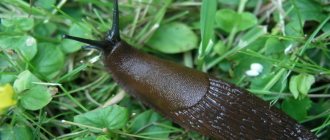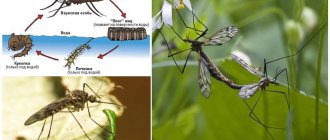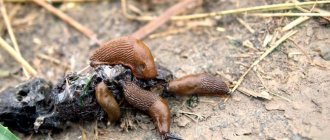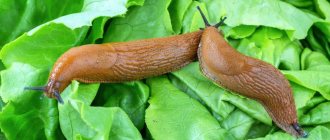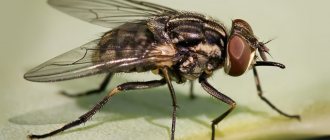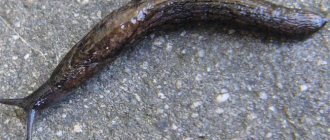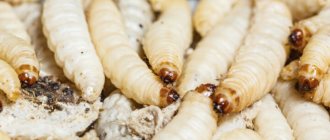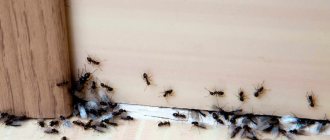A note for homeowners and a note for housewives - everything about slugs in the house, everything about methods for eliminating them. How to get rid of slugs in a private house and in urban housing, the best methods and means. About modern chemical protection products, about traps and bait, about home and folk tricks. And - about why slugs settle in the house, and how to prevent their appearance.
The appearance of slugs and where they come from in the house
Slugs are gastropods that have lost their shells during evolution. They can be found in any region of the planet with a mild, humid climate. The body of slugs is wrinkled. It can have a color from yellow-white to light gray. There may also be black spots or longitudinal stripes on the body of mollusks. There are 4 processes on the head. They are shaped like small horns.
Slugs live in gardens, fields, and vegetable gardens, but they can also get into the house. Thanks to their flexible body, capable of taking any shape, mollusks can penetrate the narrowest crevices. If there are cracks in the foundation of the house, this is a guarantee that new disgusting-looking residents will soon appear inside the house.
Since the highest humidity in the house is in the bathroom and toilet, you can most often see slugs in these rooms. Therefore, in order not to later look for where slugs entered the house from, if they are identified on the site, it is necessary to block their passage into the house and other buildings in advance.
In the house
Slugs - how to get rid of them?
There are some animals or insects, the very sight of which causes disgust in most people. All living creatures perform some kind of mission on Earth, but not many women can calmly look at this naked creature, which leaves behind nasty marks on plants or walls. As long as they don’t try to breed them in gardens or basements. And it happens that they get into apartments, causing a lot of inconvenience with their mere appearance. What are these slugs, and how can you get rid of them effectively and quickly?
What are slugs?
Let's try to study these creatures in more detail in order to choose the right method to combat them. There is such a class of animals - gastropods. Our opponents belong to them. If ordinary snails have a shell, then in slugs it is either underdeveloped or does not have one at all. They lay their eggs in the soil to a depth of approximately 20 centimeters. The larvae do not immediately come to the surface, and live in the ground for about two weeks. Simply loosening the surface layer of soil can destroy them. At the age of two or three months, slugs mature, and in a year they are capable of raising two generations. These creatures live quite a long time - up to five or seven years. During the winter, they hibernate after burrowing into the soil or fallen leaves. Both larvae and adults feed on plant foods. Most often in dachas you can find a garden or grape snail. The most damage is caused by black creatures that reach a length of up to 15 centimeters. Garden slugs are slightly smaller in size - up to 4 cm.
How to remove slugs?
But you can find them not only in the garden or in the garden. These creatures can easily get into the basement, cellar or even into an apartment.
Damage from slugs
Slugs are creatures that can cause quite significant harm to the household. If they appear in the house, indoor plants will suffer: slugs damage their stems and eat leaves.
Garden and field crops suffer in the same way from the pest. Mollusks damage sown seeds, seedlings, young shoots, parts of root crops protruding from the soil, leaves, stems of the following plant species:
- cabbage;
- cucumbers;
- tomatoes;
- beans and peas;
- strawberries;
- rye, winter wheat, barley, oats;
- potatoes and others.
Moreover, domestic slugs can carry various diseases - late blight, downy mildew, cabbage blotch, fungi, etc.
If shellfish manage to penetrate the cellar, some of the vegetables stored there will be spoiled. At the same time, most of the fruits will be unsuitable for use not from damage, but from decay, which occurs in those places where slugs have crawled.
Important ! Slugs can transmit parasitic diseases; they are intermediate and definitive hosts of various types of helminths.
Fighting slugs in the basement
Radical methods of getting rid of gastropods include a sulfur smoke bomb. It is guaranteed to kill not only the gastropods themselves, but also their larvae. Pest control in the cellar using a checker is also a preventive measure. It is important to strictly follow the instructions:
- Remove all food items from the premises, even if they are stored packaged.
- Carefully seal all holes to prevent smoke from escaping.
- Wet all surfaces generously with water. Important: metal objects must be removed. If this is not possible, they must be treated with grease or painted to prevent corrosion. Sulfur smoke, reacting with moisture, forms an acid that is very harmful to metal.
- Wear gloves, mask, goggles.
- Place sulfur bombs inside the cellar. The quantity depends on the area of the room, 6-8 square meters. m. you will need 4 pieces. Important: checkers must be placed on a fire-resistant surface. Often special stands are sold as a set.
- Light the wick using soft paper. Please note: the optimal indoor air temperature is 0 degrees. The warmer it is, the worse the sulfur will be better absorbed by the surface.
- Close the exit tightly. Smoldering lasts 0.5-1.5 hours. Do not open the basement for three days. Important: it is prohibited to use a saber in residential multi-storey buildings, because the volatile properties of the smoke are high. He is able to climb several floors. You must leave your private home during processing.
- Open all windows, doors, ventilate the cellar for a day.
- Collect dead pests and carry out wet cleaning.
- Brine for lightly salted cucumbers
- How to hem jeans
- Mucaltin - what cough to take. Treatment of all types of cough with Mucaltin tablets - instructions for use
For preventive purposes, it is recommended to carry out the following measures that will get rid of not only slugs, but also other parasites:
- periodic cleaning of the basement;
- regular drying and ventilation;
- Before placing food in the basement, you need to dry it well;
- calcareous pollination;
- treat surfaces with copper sulfate solution.
Ways to fight
You can’t delay killing slugs: they lay up to 500 eggs at a time, from which new pests appear after 2-3 weeks. After just 45 days, the young slugs will be able to lay their own eggs.
Pests can be destroyed in different ways - using chemicals, traditional methods, and physical elimination. How to deal with them - everyone decides for themselves based on their capabilities, the number of slugs in the house, on the site and other conditions.
But before you start exterminating slugs, you need to block the pests’ access to the inside of the house. To do this, you need to carefully inspect the floors, walls, especially their lower part and seal all the cracks.
Harm
Manual collection
It is best to collect slugs in the house by hand. To do this, it is enough to identify the place where they are hiding. The easiest way to do this is to follow the trail left by the mollusk.
If slugs are based under the floor, penetrating through existing cracks, you need to arrange a convenient entry point for them where it is needed so that they can be easily collected. To do this, you can leave a damp cloth on the floor. To avoid damaging wooden floors, place a piece of plastic film or a regular bag under a wet cloth.
Collected pests must be destroyed, for example, with boiling water.
Catching with baits
The fight against slugs will be more successful if you use various traps. The simplest of them is the same wet rag, but you need to soak it in beer: as it turns out, slugs really like its smell.
They are not averse to eating citrus fruits. To make a trap, you need to cut an orange, tangerine, grapefruit in half and place the halves where the mollusks live. It is necessary to place halves of the fruit with the cut side up so that slugs can crawl into it, but they will not be able to get out.
Getting rid of pests in an apartment or house is not at all difficult if you know what and how to do.
Folk remedies
There are many simple means with which you can remove mollusks, for example, such as:
- Ammonia , vinegar. The specific smell of these liquids repels slugs. Accordingly, you need to wet pieces of cloth or cotton wool with one of the selected liquids and place them in those places in the house where mollusks live.
- Insoluble coffee, salt, mustard. It is necessary to pour one of the substances onto a sheet of paper and place it in the place where there are traces of slugs on the floor, near the wall.
- Barrier device. The body of slugs is very delicate, so they can be scared away by making an obstacle out of lime, sawdust, coarse sand, crushed eggshells, and ash. As an option, you can create a barrier from pine needles. Pine or spruce needles will not only prevent slugs from entering a house or outbuilding, but also repel them with their smell.
On a note . Folk remedies generally do not destroy slugs, but repel them, so to completely eliminate the pest from your area, you will need to use chemicals.
Insoluble coffee
Chemicals
The most effective way to get rid of shellfish is to use sulfur bombs. Unfortunately, fumigation with this type of product is dangerous for people, animals, and birds.
Important ! Before use, be sure to study the instructions on how to properly use the drug in order to get rid of slugs in the house and not cause harm to anyone.
Before fumigation, it is necessary to seal all the cracks in the cellar, remove vegetables and other preparations. Place a metal sheet on the floor, place a checker on it and set it on fire. Depending on the size of the room, you will need from 1 to 4 checkers.
You must first complete all the preparatory work, and only then quickly light the wicks on all the checkers and immediately leave the room, tightly closing the door or hatch. After 72 hours, the cellar must be well ventilated. If the cellar is located under the house, it is best to leave the home for 3 days while the treatment takes place.
You can use a more gentle way to remove slugs from your home without using such radical means as a smoke bomb. We are talking about dusting the premises with bleach mixed with chalk. Prepare the room as in the previous case. Leave the mixture for a day, and then remove the dead mollusks and sweep out the remains of the mixture.
Traps and bait
Traps are made in pest habitats - an effective means of control to get rid of slugs. It is better to place them in the evening. Examples of manufacturing and operating principles of traps and baits:
| Material | Manufacturing sequence | Operating principle |
| Beer |
| The smell of beer attracts slugs. The mollusks crawl towards the scent, fall into the trap and drown. Gastropods die from boiling water. |
| Grapefruit, orange |
Please note: instead of fruit, you can take juice or compote. The liquid is poured into a container and placed next to the shellfish. Changes in a couple of days. | Slugs like the scent of citrus fruits. Once they crawl inside a fruit or a container of juice, they cannot get out. |
| Wet rags |
| Mollusks love damp and warm places. |
Prevention measures
Slugs are unpleasant neighbors that hardly anyone would like to see on their property or in their house. Therefore, it is necessary to take appropriate measures in advance to protect your home from pests:
- All places where slugs can settle should be cleaned regularly.
- Before you start collecting potatoes and other vegetables, prepare the cellar - clean it and dry it.
- Every year, whitewash the ceilings and walls of the cellar, basement, and other utility rooms with high humidity.
Of course, it is impossible to get rid of slugs forever using preventive measures, therefore, as soon as they appear on the site or in the house, you must immediately begin to destroy them.
Several recommendations for plant protection
Cornmeal poured into a trap
Slugs feed on tender leaves, making it more difficult for them to get to tied plants. Tomatoes, pumpkins and legumes tied to a support will become inaccessible to pests, given that their stems are rough and unpleasant for pests.
It is better to cover young sprouts with half a plastic bottle or a film cover - this will make them inaccessible to slugs.
An excellent bait is cornmeal poured into a trap.
The peel of half a grapefruit can be a kind of bait: if you put it on a ridge with the cut side down, making a small “entrance” for pests, they will be attracted by the smell, and then they are collected and destroyed.
Plant some plants
Remedy for hypertension Treatment should begin when the first alarming symptoms appear, since the lack of timely adequate therapy can lead to disruptions in the functioning of the cardiovascular system and brain. Today, experts recommend a new natural remedy to everyone who suffers from high blood pressure - Normaten soluble effervescent tablets. Read more…
6. Plant plants that will repel slugs with their smell and taste. Plant the following plants near those that snails like to eat: onions and garlic, legumes, bluebells, phlox, mint, mint, chicory, broccoli, violets, pansies, buttercups.
What do pests eat?
Most species of invertebrate animals are omnivores. All kinds of organic matter serve as food: foliage of any plants, mushrooms, including poisonous ones, moss on trees. Some slugs are predators, as they eat earthworms and other representatives of the order gastropods.
What crops does the slug prefer?
- Young leaves and tubers of potatoes;
- cauliflower and white cabbage;
- legume leaves, especially peas and beans;
- lettuce and grapes;
- root vegetables: tops and areas of vegetables protruding from the ground;
- all seedlings and many vegetables have young seedlings;
- garden strawberries;
- fruits of tomatoes and cucumbers;
- as well as citrus fruits: leaves and fruits.
They cause damage, but not as noticeable, to plantings of garlic, onions, and parsley. They don’t like it much, but they eat red cabbage, leaves of already ripening cucumbers and ripening strawberries. How to get rid of slugs on your property forever, since the damage they cause is so significant?
Slugs especially harm winter crops: wheat and rye, eating both sown seeds and emerging sprouts. The least liked grains are barley and oats; they very rarely visit plantations with buckwheat, flax and spring wheat.
What is also important, crawling from plant to plant, the mollusk spreads viral and fungal diseases among vegetable and garden crops:
- downy mildew;
- cabbage spotting;
- late blight
These diseases cause damage to the farm no less, and often even greater, than simply eating seedlings, leaves and fruits by spineless animals.
When the sun shines during the day, a summer resident may not even suspect that slugs and snails are hiding in secluded places where it is cool and humid. These merciless pests wait for darkness or rain to fall.
That’s when they crawl out to hunt, quickly eating plants that they encounter along their path. When there are a lot of parasites, only roots and bare shoots may remain from vegetable and fruit plants and ornamental crops. So the question facing the summer resident is: how to get rid of slugs in the garden in the fall?
Some summer residents use mild means and methods to control pests. And to combat them, chemicals (for example, granular metaldehyde) are used only in the most extreme cases.
It is worth noting the positive role of gastropods in a summer cottage: in garden beds, garden slugs, as well as snails, are “soil nurses,” as they recycle dead plant parts.
There are several hundred species of slugs in nature and not all of them are harmful. Those spineless animals that live in forests only bring benefits to nature. But among the garden pests the following are slugs: spotted slug, field slug, netted slug.
Welcome, foreign invaders...
What provoked the rapid growth in the number of slugs and their rapid spread over such a large area? A couple of online publications evasively talk about the absence of natural enemies in slugs, which leads to an uncontrolled increase in their numbers. But there is obvious deceit in this kind of approach - slugs, which have abandoned their protective shell, are in fact simple and accessible food for a huge number of carnivores
.
First of all, slugs are prey for hedgehogs, moles and shrews. A hungry rat will not disdain a slug. Many amphibians will also readily snack on slugs: frogs, toads, salamanders. Slugs are part of the diet of lizards and snakes. And there are also birds: large passerines, most ravens, many waterfowl are ready to snack on gastropods. Red roadside slug at the edge of the forest (near the reclamation ditch)
Even if all these enemies were not ready to attack an adult red slug, reaching a maximum length of 15 cm, they would destroy the vast majority of small gastropods. But this doesn't happen. For a very obvious reason - most of the listed enemies of slugs are enemies of agriculture, only larger and more visible, and not only European, but also our Russian farmers have been successfully fighting them for a long time. There are no moles - there are slugs. There are no frogs - there are slugs. There are no birds - there are slugs. Why be surprised?
Droughts in southern Europe could be a limiting factor in the spread of slugs - slugs do not know how to live in a dry climate and quickly die in the absence of moisture. Land reclamation and the transfer of agriculture to technologies using irrigation contributed to the reproduction and comfortable life of slugs. You can, of course, write abstruse articles about the influence of a comet named after an unknown astronomer on the biosphere of the planet, but in fact, we ourselves have paved convenient paths for slugs to travel and organized excellent feeding grounds for them.
In our Russian conditions, winter frost can affect the numbers of both Lusitanian and red slugs. Adults and small slugs overwinter in the soil, burrowing into it and falling into suspended animation. Our winters cannot be compared with Spanish ones; the soil in the forest can freeze several tens of centimeters deep. The size of the European alien is quite large; keeping all vital systems intact is much more difficult for him than for our ordinary slugs.
Red roadside slug in all its glory
However, the main thing for survival is for the slug eggs to survive the winter
, and this, as you know, is a completely different matter. Eggs can be stored inside the root plexuses of trees, in earthen burrows, and simply in the depths of a pile of leaves. The egg itself is a much more resilient form of life, and one slug can lay up to hundreds of eggs in one clutch. (I don’t know who thought this and how, but the figure wanders from article to article.) How often a slug can lay eggs is unknown; I have not found reliable information. Our gray slugs seem to do this once a year - in the fall, with a lifespan of 1 to 3 years. But again, these are all individual empirical data.
Nematodes
9. If you have a real pest epidemic, try purchasing nematodes at a gardening store. These are worms that parasitize snails; be sure to read the instructions before use. Spread the suspension, spray it around the area, this can be done with a broom.
See also:
Tags: pests, snails and slugs
We'll sweep it up, we'll take it out... We'll live on a bare planet.
Articles by eminent agronomists and honored farmers would further discuss how and what is the best way to lime a slug. But I will not discuss the issues of mass killing of slugs. I myself am too lazy for energetic military measures, and I consider fussing for every inch of land free from pests on a scale of six to fifteen to thirty acres to be pointless. Besides, I don’t feel the right to deprive other creatures of life just because I wanted to admire some vegetation right here and now, and they prevented it. As long as we are not talking about cultivating the land for our daily bread, there is no point in fighting what nature itself has come up with. As for what chemists and biologists came up with, let them figure it out themselves.
Red roadside slug and the hand of a 9-year-old child.
What do they not like and what are they afraid of?
Slugs do not tolerate direct sunlight, dryness and elevated temperatures. Dry soil is the scourge of slugs, which is why morning watering is recommended rather than evening watering when they start eating.
If the soil is covered with something unsuitable for crawling - sharp gravel, ash, straw or needles - it is difficult for them to move.
Slugs, having an excellent sense of smell, “cannot stand” some plants:
- onion;
- garlic;
- sage;
- oregano;
- watercress;
- geranium;
- basil;
- white clover;
- caraway;
- mustard.
Habits
Slugs, without a protective shell, are most dependent on humidity and temperature. The optimal temperature range is 15-19 degrees. Abundant humidity is also optimal, because slugs breathe not only through the lungs, but also through the surface of a wet body, so drying out leads to death.
That's why these gastropods are nocturnally active. During the day, after rain, they can also come out of hiding. During dry summers, they go into the soil and hibernate temporarily in a cocoon of mucus.
For the same reason they love dense thickets. So pulling weeds and loosening the soil makes their life more difficult.
Slugs crawl well, because they have a leg with strong muscles, and they also retract their tentacles and curl into a ball when in danger.
What do slugs eat, why and where do they come from, as well as who eats slugs in nature , read on.
Spanish snail, Lusitanian slug, red slug...
This is a relatively new inhabitant of central Russia, appearing in summer cottages near Moscow only in the last few years.
A large, rapidly reproducing, omnivorous slug with colors ranging from orange-red to dark brown is perceived by many older summer residents as a kind of mutant of the usual slugs, and conversations are usually conducted about the deterioration of the environment and the horrors of the chemical industry, and yet this gastropod is a typical example of the importation of agricultural products. pest with vegetables and fruits.
A foreign invader, so to speak. Red roadside slug (Arion rufus) Or perhaps Lusitanian slug (Arion lusitanicus)
The common names of this slug - Spanish snail, Lusitanian slug, red slug and other variations on the theme of color and place - apparently go back to the names of two species of pulmonate snails from the genus Arion: Arion rufus and Arion lusitanicus.
In Russian these are, respectively, the red roadside slug and the Lusitanian slug. The species are similar to each other; it is hardly possible to determine which one you came across among your favorite roses or in a gently cultivated greenhouse. We can definitely exclude the black variation of the slug - Arion ater is an exclusively nocturnal species that is not yet found here, and in Northern Europe it is even listed in the Red Book (although not as an endangered species). In Europe there is also a large roadside slug - but this spotted creature, growing up to 20 cm in average length, does not seem to live here yet either. (Although they write on the Internet that large slugs have taken root well in both Americas...)
Initially, red slugs lived in the south of Portugal and Spain (in the territory of the ancient Roman province of Lusitania, from which one of the species received its name). Apparently, the main food for these gastropods at first was rotting forest litter, but the development of agriculture provided red slugs with much more nourishing and larger “pastures”. Climate warming, as well as an increase in agricultural land, trade relations, globalization and other achievements of human civilization have contributed to the fact that red slugs, traveling throughout Europe, gradually acquired new habitats - preferring to capture vegetable fields, orchards, as well as grain plantings and various there are vineyards.
Until the first quarter or third of the 20th century, red slugs were considered a scourge only of their original habitats, but over the twentieth century, slugs conquered almost all of Europe
, after which they moved east, that is, towards us. It should also be noted that until the 1990s, supplies of agricultural products from Europe to Russia were simply not carried out; European vegetables and fruits came to us only a couple of decades ago. Along with them, obviously, came red slugs, which by that time in Europe had already been recognized as catastrophic pests.
